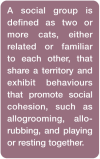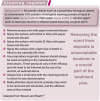Common feline problem behaviours: Unacceptable indoor elimination
- PMID: 30810090
- PMCID: PMC11373752
- DOI: 10.1177/1098612X19831202
Common feline problem behaviours: Unacceptable indoor elimination
Abstract
Practical relevance: One of the reasons why cats enjoy such a high level of popularity as domestic pets is the fact that they are clean. When there is a breakdown in this fastidious behaviour and elimination occurs outside of the litter box or tray, the strain on the cat-owner bond and on human relationships within the household can be considerable.
Evidence base: Indoor elimination behaviour is one of the most common reasons for cat owners to seek professional advice and there is a wide range of articles, book chapters and research papers that reference it. In many cases the topic of urination and defecation in unacceptable indoor locations is considered in combination with the deposition of urine or faeces as a marker, but this review focuses purely on problematic elimination. An accompanying article in this special issue discusses urine spraying.
Clinical challenges: Indoor elimination problems necessitate a clinical approach combining knowledge from the fields of physical and emotional health and an understanding of normal feline behaviour. They also require comprehensive history-taking skills as well as effective communication skills and a degree of empathy for owners who are often finding their pet's behaviour very distressing.
Global importance: Early diagnosis of physical health disorders that are associated with indoor elimination is extremely important in terms of safeguarding feline welfare. As we become more aware of the interplay between physical and emotional health, the significance of identifying suboptimal social and physical environments in terms of optimising the welfare of domestic cats is also being recognised. The potential for indoor elimination problems to cause considerable human distress highlights the importance of the concepts of One Health and One Welfare.
Keywords: Unacceptable indoor elimination; defecation; environmental needs; optimised litter facilities; urination.
Conflict of interest statement
The author declared no potential conflicts of interest with respect to the research, authorship, and/or publication of this article.
Figures

















Similar articles
-
Common feline problem behaviors: Urine spraying.J Feline Med Surg. 2019 Mar;21(3):209-219. doi: 10.1177/1098612X19831203. J Feline Med Surg. 2019. PMID: 30810092 Free PMC article. Review.
-
Advances in understanding and treatment of feline inappropriate elimination.Top Companion Anim Med. 2010 Nov;25(4):195-202. doi: 10.1053/j.tcam.2010.09.005. Top Companion Anim Med. 2010. PMID: 21147472 Review.
-
Thinking outside the box: feline elimination.J Feline Med Surg. 2004 Feb;6(1):5-11. doi: 10.1016/j.jfms.2003.09.008. J Feline Med Surg. 2004. PMID: 15123161 Free PMC article. Review.
-
Evaluation of urine marking by cats as a model for understanding veterinary diagnostic and treatment approaches and client attitudes.J Am Vet Med Assoc. 2002 Nov 1;221(9):1282-6. doi: 10.2460/javma.2002.221.1282. J Am Vet Med Assoc. 2002. PMID: 12418693
-
The environmental needs of many Australian pet cats are not being met.J Feline Med Surg. 2020 Oct;22(10):898-906. doi: 10.1177/1098612X19890189. Epub 2019 Dec 16. J Feline Med Surg. 2020. PMID: 31841057 Free PMC article.
Cited by
-
Determining priority welfare issues for cats in the United Kingdom using expert consensus.Vet Rec Open. 2019 Nov 2;6(1):e000365. doi: 10.1136/vetreco-2019-000365. eCollection 2019. Vet Rec Open. 2019. PMID: 31798909 Free PMC article.
-
Veterinary Professionals' Understanding of Common Feline Behavioural Problems and the Availability of "Cat Friendly" Practices in Ireland.Animals (Basel). 2019 Dec 10;9(12):1112. doi: 10.3390/ani9121112. Animals (Basel). 2019. PMID: 31835608 Free PMC article.
-
Laser Light Pointers for Use in Companion Cat Play: Association with Guardian-Reported Abnormal Repetitive Behaviors.Animals (Basel). 2021 Jul 23;11(8):2178. doi: 10.3390/ani11082178. Animals (Basel). 2021. PMID: 34438636 Free PMC article.
-
Feline management practices and resource provision in the UK: A questionnaire-based study of 565 caregivers.Vet Rec. 2025 Aug 2;197(3):e5561. doi: 10.1002/vetr.5561. Epub 2025 Jun 7. Vet Rec. 2025. PMID: 40482058 Free PMC article.
-
Litter box size and litter type preference and their associated behavioral changes in cats.J Vet Med Sci. 2025 Jun 1;87(6):614-620. doi: 10.1292/jvms.24-0468. Epub 2025 Apr 10. J Vet Med Sci. 2025. PMID: 40204471 Free PMC article.
References
-
- Salman MD, Hutchison J, Ruch-Gallie R, et al. Behavioral reasons for relinquishment of dogs and cats to 12 shelters. J Appl Anim Welf Sci 2000; 3: 93-106.
-
- Neilson JC. Feline house soiling: elimination and marking behaviors. Clin Tech Small Anim Pract 2004; 19: 216-224. - PubMed
-
- Herron ME. Advances in understanding and treatment of feline inappropriate elimination. Top Companion Anim Med 2010; 25: 195-202. - PubMed
Publication types
MeSH terms
LinkOut - more resources
Full Text Sources
Research Materials
Miscellaneous

